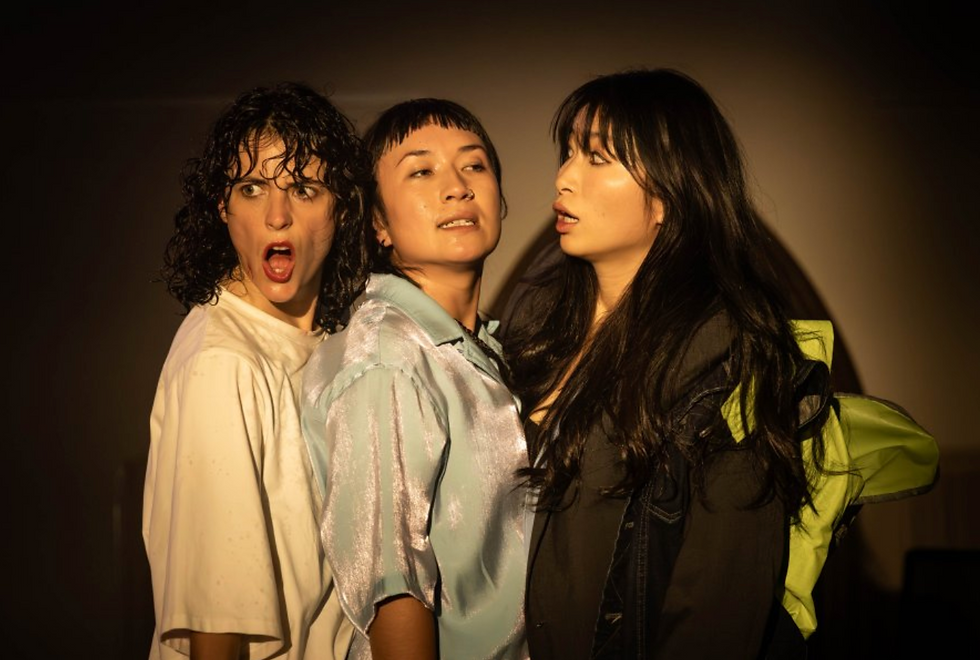Review: The Birds at Malthouse Theatre
- Theatre Travels

- May 22
- 4 min read
Review by Greg Gorton
The Birds, as adapted by Louise Fox, is a mostly-faithful retelling of Du Murier’s classic short story, with a few added elements that will most definitely draw a crowd. For one, the audience sits through the show with headphones on the whole way.
It’s a conceit which, on face value, is certainly fascinating. Practitioners playing with the ways we can use sound and lighting to enhance theatre in new ways often lead to memorable events. Going into this show, I could already imagine the possibilities - especially as The Birds is a horror story. Whispers from something not on stage, delayed echoes, and of course the flapping of birds all around us. We might very well feel assaulted ourselves.
Unfortunately, these high expectations were not met. Instead, the headphones were used for a singular (though interesting) technique. The actor was mic’ed so we heard her voice not from the stage but in our head, and the sound design was presented not from in front of us but from around. This technique was enough for some, but taking off the headphones I found myself losing nothing. Yes, I no longer heard like I was in the room with the woman, but my eyes had dismissed that illusion already.
Sadly, this was (almost) the only trick in the design basket for The Birds, and I’d argue it detracted from something quite magical - the ordinary sound design and composition by J. David Franzke. Sitting un-headphoned for those five minutes, I found those same soundscapes just as compelling and the absolute highlight of the night.
I said “almost” because one other moment in this show pops out to me and I almost felt cheated that it was only once. I had wondered at the wooden birdhouses above us and the stage from the moment I entered the theatre, and when they came into play it was awesome. I wish they had come into play more.
The lighting design for The Birds was also quite impressive. Niklas Pajanti perfectly captured the indoors and the out, the changing of time, the haunting and the real. While the design of the “bird attacks” was exactly what one might expect, they were used sparingly, which made them very effective.
The “gimmick” aside, a deeper look at the core theatrical experience leaves complex feelings for me. At the height is Paula Arundell. She deals with recitations of the original story, playing multiple characters in dialogue, and keeping the audience on their seat, all with the ease of a brilliant actor. While I wondered why a more physical-theatre-inclined actor wasn’t involved, I soon learned of Arundell’s physical challenges in this performance, being on crutches when not on stage. I was blown away by how little it was apparent during the show.
The set is minimalist, a slightly raised stage and side walls and tables used occasionally. A fireplace sits in the back corner. The use of props, however, seems arbitrary, with little thought to meaning. A mattress easily imagined is dragged on stage, but window frames are leant haphazardly against the wall.
Director Matthew Lutton does well, considering the challenges, in directing Arundell. I am unsure, however, why other characters were simply the actor using other voices, and that echoed in my ears. Could they have been performed into my ear but not on stage? Could they be voiceless? Whatever the solution, I continually faced the problem of finding the other characters to be a little less important than props.
What I most struggled with in The Birds stems from the writing choices by adaptor Louise Fox.
As stated, this is a very faithful adaptation, far more faithful than the Hitchcock movie. So faithful that very large chunks of the play are recitations of the short story itself. This might work in some very specific circumstances - a character who always speaks with such a voice, and the story being told entirely in past tense. However, using Du Murier’s magical prose means deviations are painfully obvious.
Narrative deviations (such as gender changing protagonists, updating elements to 21st century Australia) work well in helping new audiences to the story find relevance but do cause issues in the language. Descriptions from a post-war British perspective are followed up by extremely middle-class Australian dialogue from a character called Muriel. Updating the “conspiratorial” reasons offered in the story might work, except one example very much read like a misunderstanding of a popular online parody.
In one of the few narrative deviations, a final scene is more reminiscent of the gratuitous horror of Hostel or American Psycho than it is of the existential threat created within the short story. While director Lutton speaks to the power of never showing a bird, and this gratuitous horror was described, rather than shown, it was something I could never imagine Du Murier describing.
If you haven’t read Du Murier’s short story you must. This new adaptation of The Birds is a fascinating production which I’m sure many will love, and faithful enough for fans to be happy. However, the design experiment does still feel much like an experiment - a proof of concept rather than a creative way to tell a story to a live audience.





